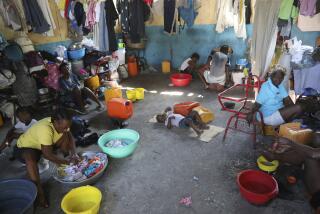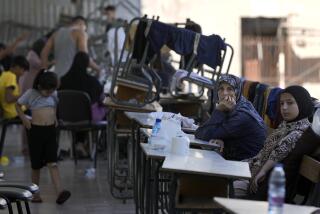Many Haitians still homeless more than six months after quake
Reporting from Corail-Cesselesse, Haiti — It was when lightning struck her tent the other day that Marie Vernita Lysius realized that the 6-month-long chain of calamities was not going to end.
Lysius’ home was crushed by the Jan. 12 earthquake, sending her into a teeming encampment of flimsy stick-and-tarp shelters. She was later bused to a better-equipped tent city on this windblown plain 15 miles north of Port-au-Prince, the Haitian capital.
Then the lightning bolt hit a support, spraying holes in her tent and injuring two family members, during a severe storm that blew down more than 300 shelters. The storm reminded the displaced that the hurricane season is upon them and that they have nowhere else to go.
“This is an example of what a hurricane can do,” said Lysius, 46, surveying a landscape pocked by collapsed tents. “Are they going to leave us out here?”
More than six months after Haiti’s catastrophic quake, a thickening sense of hopelessness hangs over the estimated 1.5 million displaced people who await more durable shelters.
“At first we thought that the way the international community was coming together that in six months we’d be off the street. But we’re still here,” said Stella Nicholas, one of 12 people crammed into a cluster of tarpaulin shelters near downtown Port-au-Prince that felt as hot and airless as the inside of a giant mitten.
“Our government is incapable of getting us out of this situation,” Nicholas said. “I hope the international community can keep our hope alive, because it’s fading.”
The earthquake triggered a massive international relief effort and inspired avowals that this was the opportunity to fix the chronic poverty and desperation that had made Haiti the most miserable corner of the Western Hemisphere. Many Haitians, though mindful of previous promises unmet, took those words to heart.
Today, spray-painted graffiti calling for the ouster of President Rene Preval have multiplied as impatience grows. National elections are scheduled in November and the earthquake response stands to be a central issue, at least in the capital. (Preval won’t be on the ballot.)
With forecasts for a potentially severe hurricane season, the most worrisome short-term problem is where to house the displaced scattered among scruffy, sunbaked tent villages, converted schoolyards and thousands of scrap-wood shacks that look like the sprouts of tomorrow’s shantytowns.
Planned transfers to more weather-resistant transitional shelters are running up against a shortage of available land.
For starters, much of Port-au-Prince is off limits because it is covered with mountains of rubble. But in a country where only about 5% of land ownership is properly registered, it is difficult to find property not already claimed by one or more owners.
“Land rights are at the bottom of all the problems we are facing,” said Timo Luege, spokesman for the 70-plus agencies working jointly on the shelter issue.
Relief workers plan to build 125,000 shelters by the summer of 2011. But they have erected only about 7,000, enough to house about 34,000. Some aid groups say the Haitian government, feeble before the quake and overwhelmed by the demands since, hasn’t spelled out a clear resettlement strategy and shows little willingness to seize private land by eminent domain.
Luege said aid workers have asked the government to endorse a provisional solution under which the groups strike informal three-year leases with owners who are vouchsafed by neighbors. The government has not answered, he said.
The camp enrollments have been swelled by people still afraid to go into houses with only mild damage and now-jobless tenants too broke to pay their rent. Others have enrolled at camps in hope of eventually getting a free house.
In Port-au-Prince, where living conditions were appalling for most people before the quake, access to clean water and toilets even in squalid encampments represents a modest step up for many.
Aid officials say the global effort has staved off the worst potential complications from the temblor, which killed more than 200,000 people, left 188,000 homes destroyed or heavily damaged and knocked down most of the Haitian government’s facilities.
Emergency assistance has prevented widespread starvation and outbreaks of disease, both of which had been feared. The violent upheaval some anticipated did not come to pass, though crime attributed to gangs is a growing concern.
More than 200,000 people have been hired temporarily to pick up rubble and clean drainage channels. And in a nation where less than half of the population had access to medical care before the quake, clinics originally set up to handle emergency cases have become essential sites for people with ordinary ailments, as well as illnesses related to conditions in the camps, such as diarrhea.
Edmond Mulet, the United Nations secretary-general’s special representative in Haiti, said he considered the progress impressive given the scale of devastation.
“It’s only six months since the largest destruction in human memory,” Mulet said in an interview. “If we had a magic wand, we would use it.”
The Interim Haiti Recovery Commission, established in April and co-chaired by Haitian Prime Minister Jean-Max Bellerive and former President Clinton, will match recovery projects with international funding promised during a conference in New York in March. Donors pledged $9.9 billion, about half of it during the next three years.
But that will take time. For now, the displaced brace for what the winds may carry next.
On a dust-blown patch next to a busy thoroughfare, Eliones St. Fort huddled inside the shack he fashioned after the quake using pieces of plywood and dimpled scraps of sheet metal. On the bed, his father-in-law groaned with severe stomach pain he said had set in three days earlier.
St. Fort, 37, an unemployed iron worker, said no government officials or aid workers had come by, and that he wasn’t about to wait for others to offer his family shelter sturdier than a tent.
“Who knows how long I’m going to be here?” he said. “This won’t stand up to a hurricane. But I did the best I could so that it will stand up to something.”
Ellingwood was recently on assignment in Haiti.
More to Read
Sign up for Essential California
The most important California stories and recommendations in your inbox every morning.
You may occasionally receive promotional content from the Los Angeles Times.










